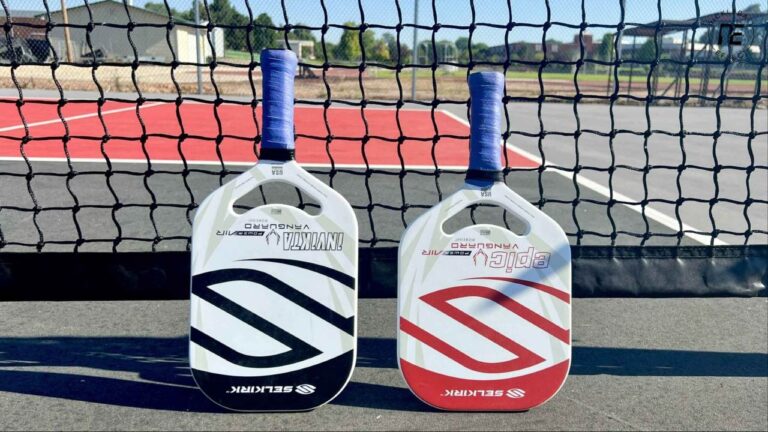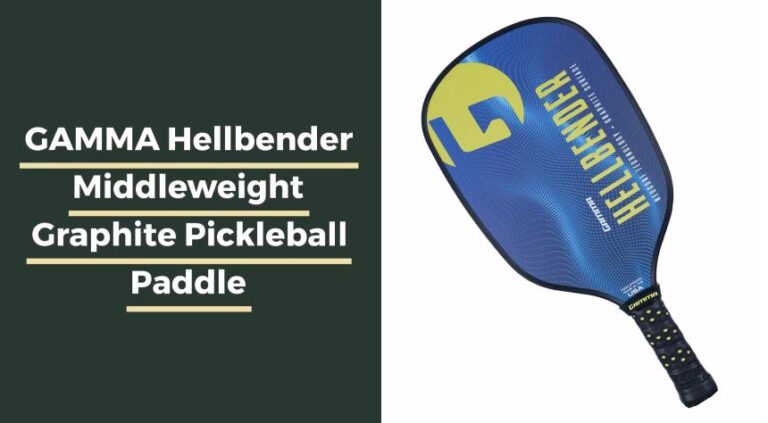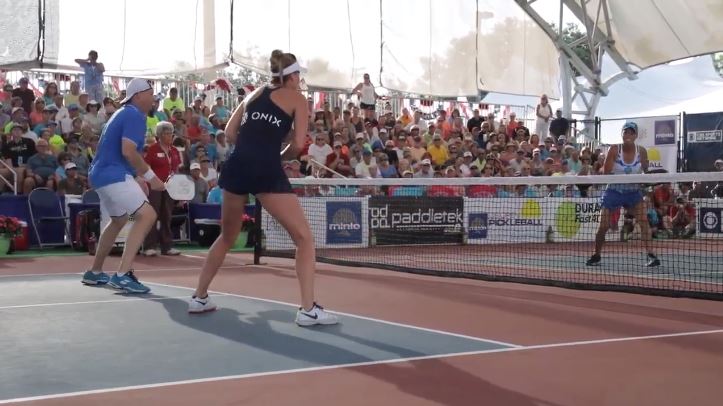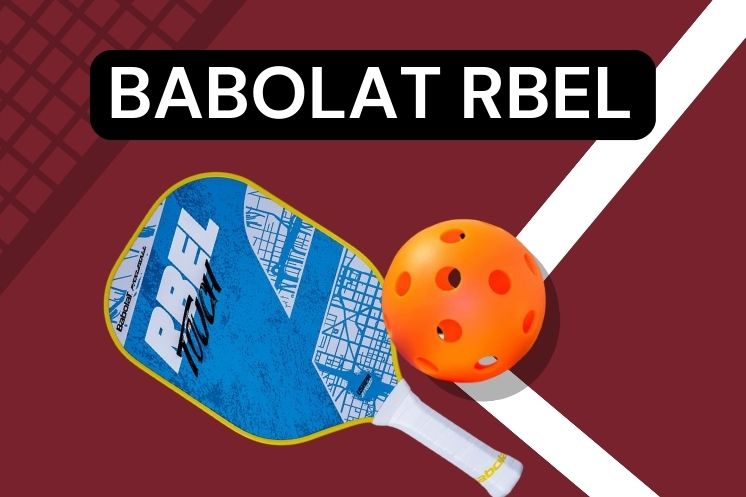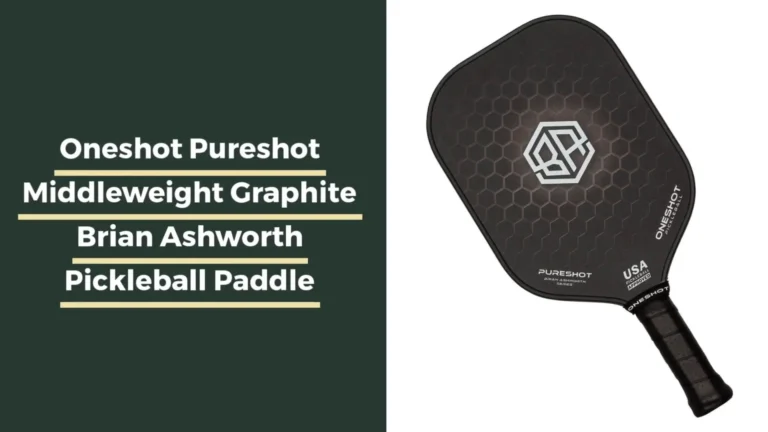
There are two main types of pickleball paddles: graphite and fiberglass. Both offer great performance, but have key differences. This guide will compare graphite and fiberglass pickleball paddles to help you choose the right paddle. We’ll cover:
- Paddle attributes like weight, power, control, cores, and durability
- How each paddle plays
- Best uses for each type
- Price considerations
- Choosing the best paddle based on playing style and skill level
After reading, you’ll understand the pros and cons of graphite and fiberglass, and how to select the ideal pickleball paddle for your game!
Graphite Pickleball Paddles
Graphite pickleball paddles are a top choice for many players due to their superior touch and control. Here’s a closer look at their key attributes:
A. Attributes and Benefits
- Lightweight – Graphite paddles are some of the lightest paddle options available, often weighing between 6-8 ounces. The graphite face is very thin but extremely rigid and robust.
- Power – Despite being lightweight, graphite still provides decent mid-level power. The lighter face generates good energy transfer for solid pops.
- Control – The lightweight stiffness of graphite offers excellent control and finesse. Graphite paddles excel at touch shots like dinks close to the net.
- Feel – Graphite has a very consistent, predictable feel and response. You’ll get great feedback with every hit.
- Touch – The leading choice for control and finesse-focused play. Ideal for spin and strategic placement.
- Durability – More durable than wood. But less durable than other materials like fiberglass.
B. How Graphite Paddles Play
When using a graphite pickleball paddle, you’ll notice:
- Very lightweight, easy swinging paddle
- Great touch and finesse on shots
- Ability to generate decent spin
- Comfortable, dampened feel on hits
- Reliable power on swing volleys and drives
- Crisp, consistent pop even on light hits
Graphite is perfect for controlled, strategic play focused on ball placement versus pure power. The paddles offer exceptional finesse for pickleball.
C. Best Uses for Graphite Paddles
Graphite pickleball paddles excel in uses like:
- Doubles play – easier to react quickly at the non-volley zone
- Controlled, dink-focused play near the net
- Finesse shots like drops, placement serves, drop volleys
- Developing touch and feel as a beginner or intermediate
- Focus on spin over power
- Transitioning from tennis – similar touch/control
Graphite suits newcomers looking to develop technical skills or competitive players prioritizing control over power. The material aids strategic play.
Many pro and competitive players use graphite to excel at ball placement and finesse shots during tournaments and matches. It’s a top choice for doubles as well. While powerful, graphite encourages working on touch.
Fiberglass Pickleball Paddles
Fiberglass pickleball paddles offer more power and a larger sweet spot versus graphite. Here’s an overview of their benefits:
A. Attributes and Benefits
- Power – The lower stiffness of fiberglass enables hard-hitting power. Great for aggressive smashes and drives.
- Control – Provides decent control but less than paddles like graphite. Fiberglass has a smaller sweet spot.
- Touch – Moderate touch and finesse. You can still perform spins and placement shots.
- Feel – Fiberglass has a more muffled, flexible feel than graphite. Provides good feedback.
- Durability – Extremely durable paddle material. Fiberglass maintains its playability for longer.
- Price – More affordable than graphite. Great performance value.
B. How Fiberglass Paddles Play
With a fiberglass pickleball paddle you’ll notice:
- Light paddle with a bigger sweet spot for power
- Ability to really drive the ball on volleys and smashes
- Good touch, but favors a more aggressive playing style
- Very durable – maintains pop and playability
- Moderate control, but slightly less finesse than graphite
- Power biased towards the center of the paddle face
Overall, fiberglass paddles promote an offense-first style of play. They excel at driving the ball with force on key shots.
C. Best Uses for Fiberglass Paddles
Fiberglass paddles are ideal for uses like:
- Aggressive, offensive style of play
- Playing singles – can attack shots easier
- Hard smashes when opponent is out of position
- Fast volley exchanges at the non-volley zone
- Developing topspin power on groundstrokes
- Highly competitive tournaments and matches
- Complementing natural power on shots
- Aerobic, fast-paced games involving net play
The extra power from fiberglass aids attacking shots and quick exchanges at the net. Fiberglass suits competitive players focused on pace and topspin.
The paddles are also great for singles matches where you need to hit aggressive winner shots. Overall an excellent choice for players with an offensive style of play who hit with inherent power.
Comparing Graphite and Fiberglass
While both are excellent materials, graphite and fiberglass paddles differ in some key areas:
A. Weight and Feel
- Graphite paddles are lighter, usually weighing 6-8oz. Fiberglass models weigh slightly more at around 7-10oz.
- The lightweight graphite provides excellent touch and feel. Fiberglass has a more muffled, dense feel.
- Graphite offers more vibration dampening for a comfortable feel.
| Paddle Material | Weight | Feel |
|---|---|---|
| Graphite | Lightweight | Optimized touch and feel |
| Fiberglass | Slightly heavier | Muted, dense feel |
B. Power and Control
- Fiberglass provides significantly more power from its flexible face.
- Graphite gives unparalleled control and finesse for spin shots.
- Fiberglass has a larger sweet spot for easily driving powerful shots.
- The smaller sweet spot of fiberglass reduces finesse slightly.
| Paddle Material | Power | Control |
|---|---|---|
| Graphite | Moderate | Superior finesse |
| Fiberglass | Maximum | Slightly less |
C. Durability
- Fiberglass is more durable long-term and retains its pop longer.
- Graphite is strong but more prone to cracking over time.
- Fiberglass easily lasts 1-2 years with frequent play.
| Paddle Material | Durability |
|---|---|
| Graphite | Moderate |
| Fiberglass | Maximum |
D. Price
- Graphite paddles range from $80-$150+ and are more expensive.
- Fiberglass models cost $50-$100, making them the budget option.
- Graphite lasts longer to justify the higher investment.
For most players, fiberglass offers the best mix of power, durability, and value. But competitive players may benefit from the superior control of graphite.
Pickleball Paddle Cores
The internal core of a pickleball paddle affects power, control, and feel. Common core materials:
A. Polymer
- Polymer (polypropylene) is the most popular paddle core.
- Provides a good balance of power, control, and touch.
- Polymer cores come in various densities:
- High-density polymer offers more pop and durability.
- Low-density polymer provides greater finesse and feel.
- Polymer is a strong, quiet, and cost-effective core.
B. Nomex
- Nomex honeycomb is a classic pickleball core material.
- Offers an ultra-high degree of power on shots.
- Can be too powerful for beginner and intermediate players.
- Very lightweight yet rigid for effortless swinging.
- Known for producing a loud “pop” sound on hits.
- Highly durable but needs control from player.
C. Aluminum
- Aluminum is a lightweight but not powerful option.
- Provides high levels of control on shots.
- Reduces power on hits – ideal for beginners learning control.
- Very quiet paddle feedback on shots.
- Overall not an ideal core material for most players.
| Core Material | Power | Control | Touch |
|---|---|---|---|
| Polymer | Medium | Medium | Medium |
| Nomex | Maximum | Low | Low |
| Aluminum | Low | High | Medium |
Polymer balances power, control, playability, and cost for most recreational to competitive players. It’s an excellent all-around option.
Nomex amplifies power significantly but requires an advanced skill level to wield effectively. Not ideal for newer players.
Aluminum heavily favors control over power and feel. Other materials like polymer offer a better blend.
Many paddle manufacturers also use proprietary core blends to optimize performance – for example, mixing polymer and aluminum. In the end, leverage your playing style and strengths to choose the right core material. An all-around polymer core suits most pickleball players very well.
Choosing Between Graphite and Fiberglass
Selecting the right pickleball paddle involves factors like playing style, skill level, and personal preference:
A. Playing Style and Skill Level
- Beginners benefit from graphite to develop finesse and technique.
- Intermediate players can advance their game with either option.
- Advanced and competitive players choose based on an offensive or controlled style.
- Doubles players lean towards graphite for quick reactions at the net.
- Singles players favor fiberglass to put away winning shots.
B. Power vs Control Preferences
- If you like placing shots strategically, opt for a graphite paddle.
- If you play aggressively and hit forceful shots, go with fiberglass.
- Don’t sacrifice too much power or control outside your comfort zone.
C. Budget Considerations
- Graphite paddles range from $80-$150+, fiberglass from $50-$100.
- Recreational players on a budget do well with fiberglass.
- Competitive players invest more in graphite for finesse advantages.
| Player Level | Preferred Material |
|---|---|
| Beginner | Graphite |
| Intermediate | Either |
| Advanced | Depends on style |
| Recreational | Fiberglass |
| Competitive | Graphite |
Think about your inherent strengths – do you tend to play with more power or control? How can a paddle complement and improve your skills?
While personal preference matters, also consider your budget, play frequency, and dedication to improving. Ultimately both graphite and fiberglass are great options!
Additional Paddle Buying Considerations
Beyond core and face materials, other factors impact your ideal pickleball paddle:
A. Weight
- Heavier paddles (8.5oz+) provide more power, lighter ones offer control.
- Novice players often prefer midweight (7.5-8.4oz).
- Lighter paddles around 7-7.5oz suit advanced finesse players.
- Find the ideal weight to complement your strength and style.
B. Grip Size
- Standard grip circumferences are 4″ or 4 1/4″.
- Choose based on your hand size and personal comfort.
- An oversized grip strains your hand, undersized risks slipping.
- Recreational players do fine with a basic 4″ grip.
C. Paddle Shape/Size
- Average dimensions are about 15.5″ long x 8″ wide.
- Larger surface areas provide a bigger sweet spot.
- Smaller paddle heads offer more finesse and control.
- Longer, wider paddles suit doubles, smaller ones for singles.
| Paddle Aspect | Beginner Choice | Advanced Choice |
|---|---|---|
| Weight | Midweight | Varies |
| Grip Size | 4″ | Based on hand |
| Shape/Size | Standard | Depends on game play |
Test paddles across a range of weights and sizes to choose what feels best. An extended demo period helps dial in preferences. Don’t settle on a paddle without experiencing the in-game feel. While core and face materials significantly impact performance, these custom fit factors help you further refine the paddle’s playability and effectiveness.
People also ask
Conclusion
Deciding between graphite and fiberglass pickleball paddles ultimately depends on your playing style and priorities. Here’s a recap of the key differences:
A. Summary of Key Differences
- Graphite is lighter and optimized for finesse and control. Fiberglass provides more power from its flexible face.
- The lower stiffness of fiberglass enables harder-hitting shots. Graphite gives unrivaled touch and spin capabilities.
- Graphite offers a more dampened, consistent feel. Fiberglass has a dense, muted feedback.
- Fiberglass is significantly more affordable, while graphite suits serious competitors.
- For durability, fiberglass lasts longer. But graphite provides a more precise, high-performance touch.
B. How to Select the Right Paddle
- Identify your skill level and style of play. What feels more natural – controlled placement or aggressive power?
- Consider your budget. Fiberglass provides excellent value for recreational games.
- Think about your upcoming matches – doubles or singles? Finesse or force?
- Test paddle weights and grip sizes to find the ideal fit beyond materials.
- Demo graphite and fiberglass paddles to compare power, touch, and feel.
- Choose the material aligning closest with your game tendencies and goals.
- Consider a hybrid if you want the best of both paddle types.
Keep an open mind – your preferences may evolve over time as your abilities improve! With practice, you may gravitate from fiberglass towards graphite for refined control.
The Right Pickleball Paddle Boosts Your Strengths
Whichever design you choose, the perfect paddle becomes an extension of your arm to boost power, touch, and consistency. We hope this guide gave you the insights needed to pick the ideal graphite or fiberglass pickleball paddle for taking your game to the next level!

